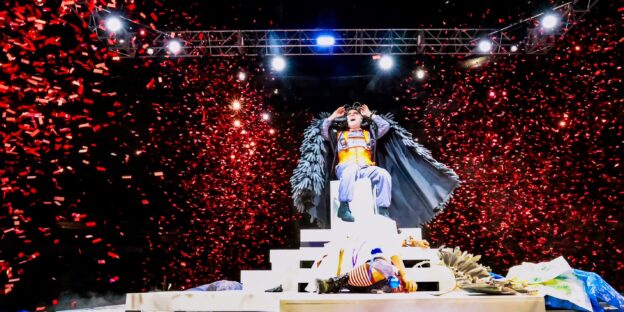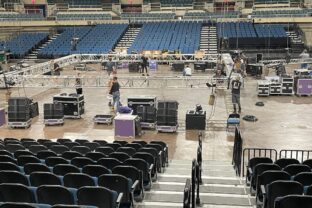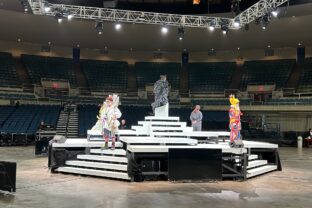
HANA HOU | MARCH 2024
Ridi, Pagliaccio, e ognun applaudirà! Laugh, Pagliaccio, and everyone will applaud!
Those words from the famous aria, “Vesti la giubba”, sung by Canio in Leoncavallo’s opera Pagliaccio, express his desperation in facing the real possibility that his wife is having an affair. For now, the audience is waiting, so he has to get dressed and put on a good show.
That sentiment, though obviously for very different reasons, seemed highly relatable to all those who nearly tore hair out in creating a powerful theatrical experience last month at the Blaisdell Arena. I’m proud of what we achieved, but it certainly was a bumpy ride!
As you know, HOT is without our longtime performing venue, the Blaisdell Concert Hall, this season due to renovations. [As of this writing, the hall will remain closed until early 2025, which means our fall production will also need a different home. More on that soon. And fingers crossed it will be done in time for February 2025…we’re slated to be the first group back following the closure.] That has required us to do what any good arts organization does: get creative! So, we started at the Moanalua High School Performing Arts Center for An American Dream last October. That powerful chamber opera fit perfectly in the beautiful new theatre. Those of you who managed to find it discovered a true gem: a beautiful facility with excellent acoustics and free parking.
But HOT has a long history of grand opera, and finding suitable spaces for something with cast, chorus, and an orchestra of 60+ musicians presented us with few options. So, the Arena for Pagliaccio, and the Tom Moffatt Waikiki Shell for Puccini’s beloved La Bohème at the end of April.
These three venues have presented many challenges, including a “fear of the unknown” reaction from some of our longtime patrons, multiple seating configurations for each, and more. But the biggest hurdle really has been from the technical side at the Arena and Shell – questions we don’t normally have to ask ourselves: Do we need sound amplification? How do we light the stage? How do we create a stage? Are there dressing rooms? How do we (and more, can we) display supertitles? And so much more.
For Pagliaccio, director Jamie Offenbach wanted to present the piece in the round. It was a brilliant move dramatically, allowing the audiences to be as close to the action as possible in that huge space and fitting the “post-apocalyptic” carnival-like atmosphere he wanted. But it created nearly as many technical challenges as it addressed.
 Unlike the Concert Hall, the Arena does not have theatrical lighting permanently installed, so everything has to be rented, with a structure built and suspended over the performing area to hang the lights, etc. [The Shell has a similar issue.] Our Director of Production, Gordon Svec, worked with our own amazing crew and staff from Onstage Hawaiʻi to create and suspend (in theatre, it’s called “flying”) the large, square framing that held all the lighting. Our partnership with set designer Michelle Bisbee once again proved to be a gift that keeps on giving, as she designed the multi-level platform structure where all the action took place.
Unlike the Concert Hall, the Arena does not have theatrical lighting permanently installed, so everything has to be rented, with a structure built and suspended over the performing area to hang the lights, etc. [The Shell has a similar issue.] Our Director of Production, Gordon Svec, worked with our own amazing crew and staff from Onstage Hawaiʻi to create and suspend (in theatre, it’s called “flying”) the large, square framing that held all the lighting. Our partnership with set designer Michelle Bisbee once again proved to be a gift that keeps on giving, as she designed the multi-level platform structure where all the action took place.
At the Concert Hall, the orchestra goes in the pit, with the conductor facing the stage so they can easily connect with the performers, ensuring everything goes smoothly musically. But in a wide-open space like the Arena, that’s not possible. With the audience seated on all four sides of the stage, that placed the orchestra and conductor behind one section of seating. Elizabeth Askren, our newly appointed Principal Guest Conductor, was raised up enough so she could watch the action and the singers could see her…but only when they were facing in that direction. So that meant placing large TV monitors on all four corners of the stage, facing in, so they could see her beat. But that didn’t help her when singers were on the opposite side of the stage. She likened it to steering a large ship without being able to see where you’re going. There were definitely some tense moments in rehearsal, but thankfully came together beautifully by the two performances.
Speaking of rehearsal, we normally have two weeks at the Concert Hall – and that’s without having to build stages and hang lighting equipment on structures that aren’t already in the venue. With all three spaces this season, we have just one week. So, there’s definitely been more “burning the midnight oil” that usual, which is why we haven’t been able to open up dress rehearsals for students this season like we’ve done for many years. (Instead, they’ve been invited to attend the actual performances, which has proven popular.)
to build stages and hang lighting equipment on structures that aren’t already in the venue. With all three spaces this season, we have just one week. So, there’s definitely been more “burning the midnight oil” that usual, which is why we haven’t been able to open up dress rehearsals for students this season like we’ve done for many years. (Instead, they’ve been invited to attend the actual performances, which has proven popular.)
Sound. Oh, sound! Opera is an art form for singers who can fill up a theatre with the sheer dramatic power of their voice. But when you are presenting in a space as cavernous as the Arena, or even the Shell, we have to take a different approach. So that meant bringing in experts from Rhema Services, a Honolulu-based company that specializes in sound reinforcement for rock concerts, conventions, and more. We own “body” microphones (units that attach to an individual performer in some way and transmit a signal to a sound board and then speakers), which are usually limited to operas with spoken dialogue. So, we started with our own mics, paired with equipment from Rhema, and they seemed to be working fine. Until they weren’t, just three days before we opened. So Rhema came to the rescue with a whole new set of mics for the singers which we had for exactly ONE rehearsal prior to opening. Oh, and the entire orchestra had to have sound amplification too…though in the end, we decided to use it just for the strings as the brass and winds carried quite well in the space. But wait…there’s more: we also had to have monitors (speakers facing the performers, and speakers facing the conductor) so everyone could hear each other. I have no idea how many yards of cable we ended up using, but it was a lot!
Supertitles…our Achilles Heel. For months and months, we wracked our brains on whether or not we could provide supertitles for Pagliaccio. With audiences on four sides, hanging (flying) screens would have been prohibitively expensive (four screens, four projectors, more structure built to hold them), and to keep them low enough so audiences sitting in sections on the floor could see them without breaking necks would have gotten in the way of the lighting. But the idea of four large monitors set on the floor seemed like the only possible solution. We knew they wouldn’t be visible to some audiences, but we didn’t know how bad the sight lines would be until the last rehearsal when chairs had finally been set up for our seating configuration. And at that point, it was too late. We considered raising the monitors a bit, but to really solve the issue it would have created a new – and we thought, worse – issue by blocking the stage.
We will be back in the Arena next fall but will be using a different seating configuration that will make supertitles much easier to deliver. And I promise that they’ll be viewable from all seats for our April performances at the Waikiki Shell!
Opera is never easy to produce. It is big and expensive with many moving parts. But that is absolutely what makes it the most powerful artform there is to me. Opera is truly the most complete and collaborate of all artforms, and there is nothing else like it.
Mahalo nui loa for making the magic possible!
A hui hou!
Andrew
